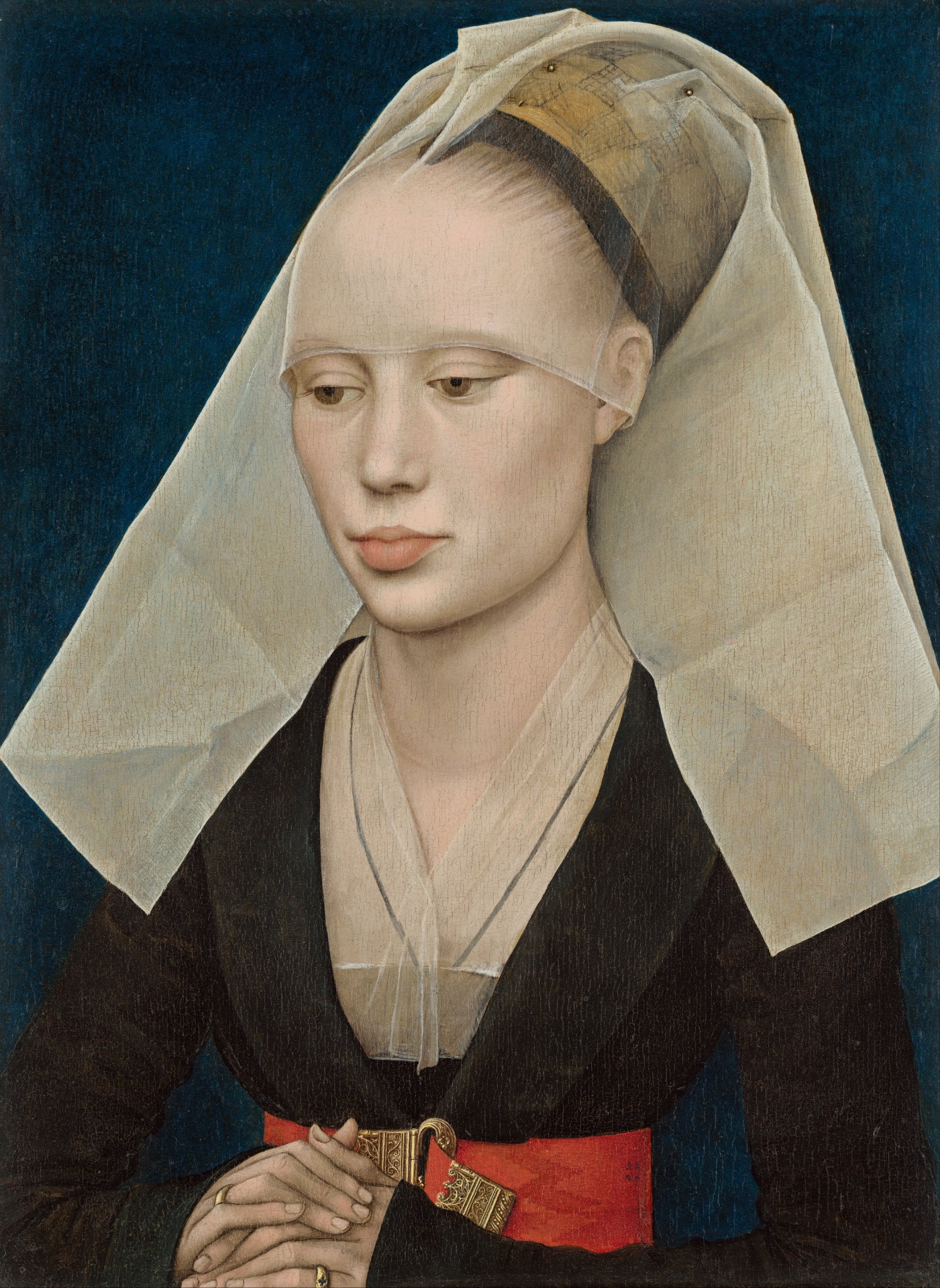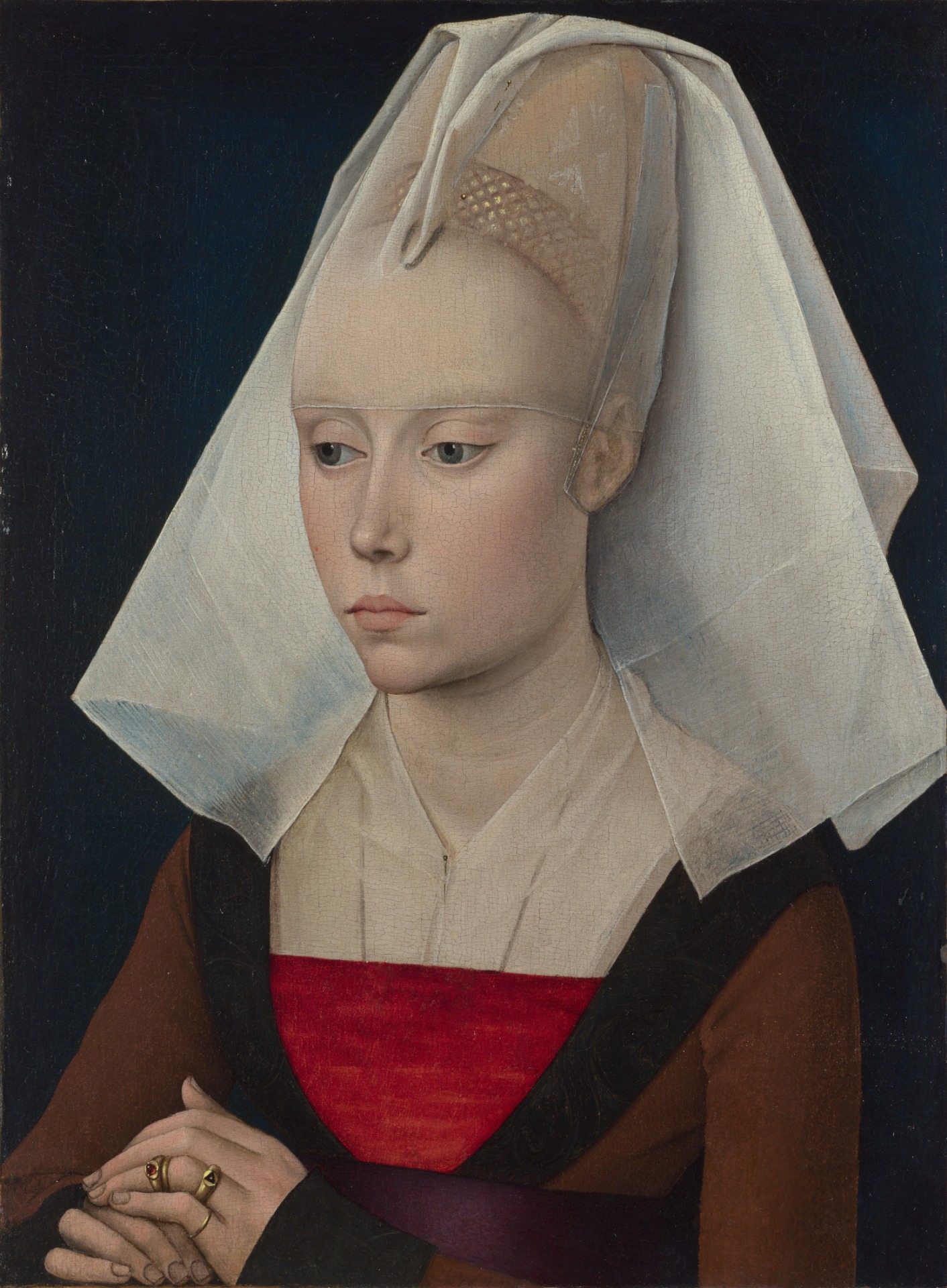Artistul lunii ianuarie 2023 - Rogier van der Weyden
Location: The National Gallery, London
The woman's large white headdress, its calligraphic shape made up of stiff, angular folds, is striking against the dark background. Shading around the folds reinforces the sense of their depth, and the artist seems to want us to think that a fly, deceived by his illusion, has attempted to land on the headdress. The fly is, of course, also part of the deception and perhaps intended to reinforce the artist's mastery. With slim fingers, the sitter gestures towards a sprig of forget-me-nots. The flowers were sometimes a symbol of marriage, so she may have been portrayed to commemorate an engagement, but they also refer to remembrance. Perhaps they are an invitation to remember the sitter through this portrait when absent, or even after her death. The inscription at the top of the painting reads: GEBORNE HOFERIN. This means that the woman is from the Hofer family, but as this was a common surname in southern Germany at the time it doesn't help to identify her.
Portrait of a Lady (or Portrait of a Woman) is a small oil-on-oak panel painting executed around 1460 by the Netherlandish painter Rogier van der Weyden. The composition is built from the geometric shapes that form the lines of the woman's veil, neckline, face, and arms, and by the fall of the light that illuminates her face and headdress. The vivid contrasts of darkness and light enhance the almost unnatural beauty and Gothic elegance of the model.
Van der Weyden was preoccupied by commissioned portraiture towards the end of his life[1] and was highly regarded by later generations of painters for his penetrating evocations of character. In this work, the woman's humility and reserved demeanor are conveyed through her fragile physique, lowered eyes and tightly grasped fingers.[2] She is slender and depicted according to the Gothic ideal of elongated features, indicated by her narrow shoulders, tightly pinned hair, high forehead and the elaborate frame set by the headdress. It is the only known portrait of a woman accepted as an autograph work by van der Weyden,[1] yet the sitter's name is not recorded and he did not title the work.
Although van der Weyden did not adhere to the conventions of idealisation, he generally sought to flatter his sitters. He depicted his models in highly fashionable clothing, often with rounded—almost sculpted—facial features, some of which deviated from natural representation. He adapted his own aesthetic, and his portraits of women often bear a striking resemblance to each other.[3]
The painting has been in the National Gallery of Art in Washington, D.C. since its donation in 1937, and is no. 34 in the de Vos catalogue raisonné of the artist. It has been described as "famous among all portraits of women of all schools".[4]
Van der Weyden worked in the same tradition of portraiture as contemporaries Jan van Eyck[note 4] and Robert Campin.[note 5] In the early to middle 15th century, these three artists were among the first generation of "Northern Renaissance" painters, and the first northern Europeans to portray members of the middle and upper classes naturalistically rather than in a medieval Christian idealized form. In earlier Netherlandish art the profile view was the dominant mode of representation for the nobles or clergy worthy of portraiture.[19] In works such as Portrait of a Man in a Turban (1433), Jan van Eyck broke this tradition and used the three-quarter profile of the face which became the standard in Netherlandish art. Here, van der Weyden utilizes the same profile, which better allows him to describe the shape of the head and facial features of the sitter.[20] She is shown in half-length, which enables the artist to show her hands crossed at her waist.[21][22]
Despite this new freedom, van der Weyden's portraits of women are strikingly similar in concept and structure, both to each other[3] and to female portraits by Campin.[note 6] Most are three-quarter faces and half-length. They typically set their models in front of a dark background that is uniform and nondescript. While the portraits are noted for their expressive pathos,[23] the facial features of the women strongly resemble one another. This indicates that although van der Weyden did not adhere to the tradition of idealized representation, he sought to please his sitters in a manner that reflected contemporary ideals of beauty. Most of van der Weyden's portraits were painted as commissions from the nobility; he painted only five (including Portrait of a Lady) that were not donor portraits.[note 7][24] It is known that in his Portrait of Philip de Croÿ (c. 1460), van der Weyden complimented the young Flemish nobleman by concealing his large nose and undershot jaw.[12] When describing this tendency in relation to the Washington portrait, art historian Norbert Schneider wrote, "While van Eyck shows nature 'in the raw', as it were, Rogier improves on physical reality, civilising and refining Nature and the human form with the help of a brush."[10] The high quality of the painting is highlighted when compared to the National Gallery's very similar workshop painting. The London subject has softer, more rounded features and is younger and less individually characterized than the c. 1460 model. The technique also is less subtle and fine in the London work.[25] However, both share similar expressions and dress.[3]
Van der Weyden was more concerned with the aesthetic and emotional response created by the pictures overall than in the specific portraits. Art historian and curator Lorne Campbell suggests that the popularity of the portrait is due more to the "elegant simplicity of the pattern which [the sitter] creates" than to the grace of her depiction. While van der Weyden did not stay within the traditional realms of idealization, he created his own aesthetic, which he extended across his portraits and religious pictures.[26] This aesthetic includes the mood of sorrowful devotion which forms the dominant tone in all his portraits. His figures may be more natural than those of earlier generations of artists; however, his individualistic approach to the depiction of his sitters' piety often leads to the abandonment of the rules of the scale.[13]
John Walker, former director of the National Gallery of Art, referred to the subject as "outré", but believed that despite the awkwardness of her individual features, the model was nonetheless "strangely beautiful".[15] By the time of the work's completion, van der Weyden had eclipsed even van Eyck in popularity, and this painting is typical of the austere spirituality, of the latter's sensuality, for which van der Weyden is renowned.
References:
- Brown, David Alan (2003). Virtue and Beauty: Leonardo's Ginevra de' Benci and Renaissance Portraits of Women. Princeton University Press. ISBN 978-0-691-11456-9
- Campbell Lorne, Foister, S, Roy. A. "Early Northern European Painting". National Gallery Technical Bulletin, volume 18, 1997
- Campbell, Lorne. The Fifteenth Century Netherlandish Schools. London: National Gallery Publications, 1998. ISBN 1-85709-171-X
- Campbell, Lorne. Van der Weyden. London: Chaucer Press, 2004. ISBN 1-904449-24-7
- Campbell, Lorne and Van der Stock, Jan. (ed.) Rogier van der Weyden: 1400–1464. Master of Passions. Leuven: Davidsfonds, 2009. ISBN 978-90-8526-105-6
- De Vos, Dirk. Rogier van der Weyden: The Complete Works. Harry N Abrams, 2000. ISBN 0-8109-6390-6
- Friedlænder, Max J. "Landscape, Portrait, Still-Life: Their Origin and Development". New York: Schocken Books, 1963
- Grössinger, Christa. Picturing women in late Medieval and Renaissance art. Manchester: Manchester University Press, 1997. ISBN 0-7190-4109-0
- Hand, John Oliver and Wolff, Martha. Early Netherlandish Painting. Washington: National Gallery of Art, 1986. ISBN 0-521-34016-0
- Kemperdick, Stephan. The Early Portrait, from the Collection of the Prince of Liechtenstein and the Kunstmuseum Basel. Munich: Prestel, 2006. ISBN 3-7913-3598-7
- Kleiner, Fred S. Gardner's Art Through the Ages: The Western Perspective. Belmont: Wadsworth Publishing, 2009. ISBN 0-495-57364-7
- Monro, Isabel Stevenson and Monro, Kate M. Index to Reproductions of European Paintings: A Guide to Pictures in More Than Three Hundred Books. New York: H. W. Wilson, 1956.
- Panofsky, Irwin. Early Netherlandish Painting: v. 1. Westview Press, 1971 (new edition). ISBN 978-0-06-430002-5
- Scott, Margaret. The History of Dress: Late Gothic Europe, 1400–1500. London: Humanities Press, 1980. ISBN 0-391-02148-6
- Schneider, Norbert. The Art of the Portrait: Masterpieces of European Portrait-Painting, 1420–1670. Taschen GmbH, 2002. ISBN 3-8228-1995-6
- Smith, Jeffrey. The Northern Renaissance. London: Phaidon, 2004. ISBN 0-7148-3867-5
- Van Der Elst, Joseph. The Last Flowering of the Middle Ages. Montana: Kessinger Publishing, 1944.
- Walker, John. National Gallery of Art, Washington. New York: Harry N. Abrams, Inc, 1975. ISBN 0-8109-0336-9
- Wilson, Jean. Painting in Bruges at the Close of the Middle Ages: Studies in Society and Visual Culture. Pennsylvania State University Press, 1998. ISBN 0-271-01653-1
Notes
Van der Weyden often worked on commissions from members of the Burgundian court. See Schneider, 40
A plucked hairline was also the fashion in Renaissance Italy at the time.
Philip the Good commissioned a portrait from Van der Weyden around 1450
While van der Weyden would have seen van Eyck's work, it is not known if the two met. Van Eyck died in 1441
He was apprenticed to Campin in 1426. See Friedlænder, 16
The similarity between van der Weyden and Campion's female portraits is so strong that they were sometimes misattributed. See Campbell, 19
Portraits were at the time a common means of initiating marriage alliances. Christus, van Eyck and van der Weyden were known to have been employed for this reason. In particular, the extent and level of detail that Christus and van der Weyden undertook to make their subjects appear attractive suggest this was often a primary motive. See Wilson, 47–48
Portraits in the Anhalt collection were generally poorly catalogued in early inventories

